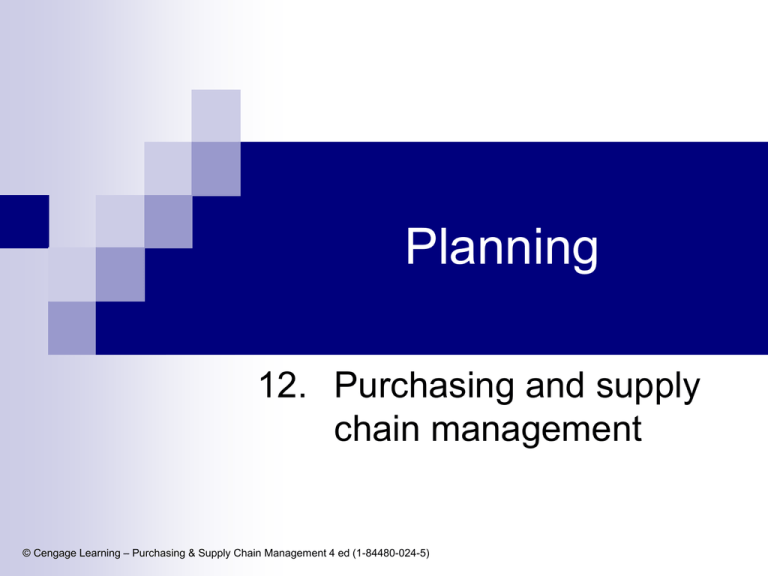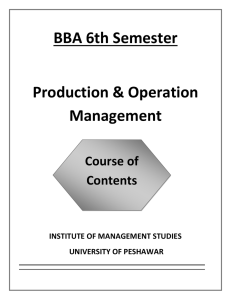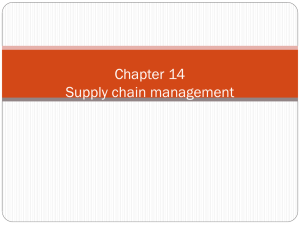Supply Chain Management
advertisement

Planning 12. Purchasing and supply chain management © Cengage Learning – Purchasing & Supply Chain Management 4 ed (1-84480-024-5) Program Purchasing and supply chain management: definitions Materials requirements planning Basic logistics structures Just-in-time management (JIT) Consequences for suppliers Scheduling problems between purchasing and logistics Elements of the purchasing system © Cengage Learning – Purchasing & Supply Chain Management 4 ed (1-84480-024-5) Purchasing and Supply Chain Management: definitions Customer Manufact. Purchasing Marketing & logistics Physical Distribution 1st Tier Supplier Materials management Logistics management Business Logistics Demand Chain Management Supply Chain Management Value Chain Management © Cengage Learning – Purchasing & Supply Chain Management 4 ed (1-84480-024-5) 2nd Tier Supplier Purchasing and Supply Chain Management: definitions Materials management encompasses all materials related activities aimed at optimizing the incoming materials flow from the supplier to production. Logistics management encompasses all materials flows, from the flows of purchased materials into a facility, through the manufacturing process, and out to the customer. Supply Chain Management (SCM) is a connected series of activities which is concerned with planning, coordinating and controlling material, parts, and finished goods from suppliers up to the customer. Purchasing and Supply management can be seen as an integrated part of SCM © Cengage Learning – Purchasing & Supply Chain Management 4 ed (1-84480-024-5) Materials requirements planning MRP starts in the sales department with drawing up a sales plan, providing an estimate of the volume to be sold. MRP is the input for the manufacturing planning and control system consisting of: Master planning Plans at the level of the product families (product groups) are established. Customer orders, sales plan, planned stocks of finished products and the production and purchasing plans are linked together Manufacturing Resources Planning (MRP-II) Records the Manufacturing Resources needed to realize the master plan. © Cengage Learning – Purchasing & Supply Chain Management 4 ed (1-84480-024-5) Materials requirements planning Master production scheduling (MPS) Translates the master plan into specific materials requirements. MPS provides the input for calculating the net materials requirements. General capacity testing The MPS should be tested for capacity limitations and this should be done for all potential bottleneck capacities. Materials requirement planning (MRP-I) The materials requirements planning explodes the requirements from the MPS level on a weekly basis, step by step, in accordance with the bill of materials. Capacity requirements planning Conceptually comparable with materials requirements planning. The current and planned manufacturing orders from the mrp provide the input for the detailed production line planning © Cengage Learning – Purchasing & Supply Chain Management 4 ed (1-84480-024-5) Materials requirements planning Order release Order releases change the status of the manufacturing orders from ‘planned’ to ‘released’. The decision to release is based on the availability of the required materials and capacity. Priority management The priorities are directly derived from the MPS. Each unit receives a priority sheet which lists all manufacturing orders for that line or machine center. Capacity Management Waiting times per processing group have to be controlled. Input/output reports have an important function: to compare the realized output for a production unit against its planned output. © Cengage Learning – Purchasing & Supply Chain Management 4 ed (1-84480-024-5) Manufacturing planning and control system Resource Planning Production Planning Demand management Rough-cut capacity planning Master production scheduling Front end Routing file Detailed capacity planning order release Shop-floor control Bills of Materials Material requirements planning Time-phased requirements record Inventory status data Engine Materials and capacity plans Purchasing Vendor follow-up systems © Cengage Learning – Purchasing & Supply Chain Management 4 ed (1-84480-024-5) Back end Materials requirements planning Difference MRP-I and MRP-II MRP-I stands for materials requirements planning; aims at releasing and managing manufacturing orders and purchasing requisitions. MRP-II stands for manufacturing resources planning, an integrated system that controls relevant materials flows and production capacity while also taking into account the relationship between these materials flows and the required capacity. © Cengage Learning – Purchasing & Supply Chain Management 4 ed (1-84480-024-5) Basic logistics structures Order decoupling point (or order penetration point): Indicates how deeply the customer order penetrates the firm’s materials planning systems Defines from what moment on a production order becomes customer specific. © Cengage Learning – Purchasing & Supply Chain Management 4 ed (1-84480-024-5) Basic logistics structures Five basic manufacturing and logistics structures 1. Making and sending to stock (MSS) • Products are manufactured and distributed to distribution points which are dispersed and located close to the customer. E.g. sweets, foods, beverages. 2. Making to (central) stock (central stock • Finished products are kept in stock at the end of the production process and are from there shipped to geographically dispersed customers. E.g. dairy products. 3. Assembly to order (ATO) • Only systems elements, modules or subassemblies are in stock at the manufacturing center, whereas final assembly takes place based on a specific customer order. E.g. cars, computers. 4. Making to order (MTO) Only raw materials and components are kept in stock. Every customer is a specific project. E.g. beer and lemonade cans, basic construction materials 5. Engineering and making to order (ETO) • No stock at all. The purchase and order of materials takes place based on the specific customer order. E.g. construction companies and shipyards. © Cengage Learning – Purchasing & Supply Chain Management 4 ed (1-84480-024-5) The order decoupling point concept Supplier IG Components Manufacturing WIP Assembly EP Production Make and send to stock (MSS) Installation OP3 Examples OP1 Kitchen appliances Assemble to order (ATO) Make to order (MTO) Customer Sales/marketing OP2 Make to stock (MTS) OP4 EP Computer systems High-end furniture Ship propelling diesel engines OP5 IG= Incoming goods EP= End products WIP= Work in Progress OP= Order pentration point Engineer and make to order (ETO) Shipbuilding = Inventory =Order driven =forecast driven © Cengage Learning – Purchasing & Supply Chain Management 4 ed (1-84480-024-5) (Hoekstra and Romme, 1985) Just-in-time management (JIT) Characteristics of JIT management: JIT All materials and products become available at the very moment when they are needed in the production process, not sooner and not later but exactly on time and exactly in the right quantity. Major objective Continuously tackle and solve manufacturing bottlenecks within, and interfaces between, consecutive steps in the manufacturing process. © Cengage Learning – Purchasing & Supply Chain Management 4 ed (1-84480-024-5) Just-in-time management (JIT) Order Quantities and batch sizes Economic Order Quantity: where the sum of inventory costs and ordering costs is lowest Camp’s formula: Qo= √ ((2S x Co)/Ci) S= Q= Co= Ci= fixed usage per period order quantity costs per order inventory carrying costs for one unit during one unit time © Cengage Learning – Purchasing & Supply Chain Management 4 ed (1-84480-024-5) Just-in-time management (JIT) Conditions Camp’s formula: The consumption of the component at hand is fairly stable The consumption of the component is evenly spread over the course of time The delivery time of the product is fixed and not due to fluctuation the ordering costs per order are fixed the inventory carrying costs do not depend on the ordered quantity JIT basically challenges each of these assumptions. E.g. order-related costs are analyzed in terms of costs related to: Negotiations with the supplier Administrative processing Follow-up and expediting of orders Incoming and quality inspections © Cengage Learning – Purchasing & Supply Chain Management 4 ed (1-84480-024-5) Just-in-time management (JIT) Towards a reduction of the economic order quantity © Cengage Learning – Purchasing & Supply Chain Management 4 ed (1-84480-024-5) Just-in-time management (JIT) JIT production and scheduling cannot successfully implemented without a zero defects philosophy JIT and zero defects need to go hand-in-hand: Smaller batches make it necessary to detect quality defects at an early stage JIT must be supported by all functions within the company Adopting JIT will take time (It took Toyota 15 years to implement he KANBAN philosophy) © Cengage Learning – Purchasing & Supply Chain Management 4 ed (1-84480-024-5) Just-in-time management (JIT) JIT and the purchasing function Purchasing activity Traditional approach Supplier selection Minimum of 2 suppliers; price is central Often one local supplier; frequent deliveries Change of orders Delivery time and quality often changed at the last moment Delivery time and quality fixed; quantities are adjusted within predetermined margins if necessary Follow-up orders Many phone calls to solve delivery problems Few delivery problems thanks to sound agreements; quality and delivery problems are not tolerated Incoming inspection Inspection of quality and quantities of nearly every delivered order Initial sample inspections; later, no inspections necessary Supplier assessment Qualitative assessment; delivery Deviations are not accepted; price is deviations of sometimes up to 10% are fixed based on open calculation tolerated Invoicing Payment per order © Cengage Learning – Purchasing & Supply Chain Management 4 ed (1-84480-024-5) JIT approach Invoices are collected and settled on a monthly basis Consequences for suppliers Advantages of JIT for a supplier Supplier is able to plan his production volume much better because he’s informed regularly about the quantities to be delivered. Administrative savings: supplier’s and customer’s production and materials planning systems are linked through electronic information systems (like EDI), Constant communication on quality and costs improvements can lead to product and process innovation Investment policy: JIT contracts are signed for a long period of time and guarantee a certain volume and turnover over that time period © Cengage Learning – Purchasing & Supply Chain Management 4 ed (1-84480-024-5) Consequences for suppliers Disadvantages of JIT for a supplier It may result in a pyramid shaped structure with a strong hierarchy in the different links of the supply chain. The large manufacturers at the top of the pyramid impose their demands ruthlessly on the often smaller first tier suppliers It takes time (and money) to deliver at zero defects or to produce zero defects. These investments come at the expense of the supplier Supplier can become very dependent on only one manufacturer. This can become a threat to its continuity. © Cengage Learning – Purchasing & Supply Chain Management 4 ed (1-84480-024-5) The supplier Pyramid ‘A’ Company Finished car prod In-houseIn house assembly. Manufactt materials manufacturers (200-300 companies) The first supplier Capital involvement 118 supplying of company ‘A’ in38 companies for supplying companies company ‘A’ Function parts, mounting parts for inside and outside mechanical reworking, press reworking The secondary supplier other secondary suppliers 2000-3000 companies Press, gilding cutting, screw, casting, specials parts reworking The other third suppliers 7000-10000 companies © Cengage Learning – Purchasing & Supply Chain Management 4 ed (1-84480-024-5) 500-600 companies Tooling, mould, fittings Consequences for suppliers JIT and supplier selection Suppliers located near the JIT-partner are in an advantageous position Business based on open calculation ‘Quality on Time’ Supplier classification: On time delivery Quality delivery A= excellent B=good C= inadequate 1= excellent 2= good 3= inadequate Example: C1 supplier provides high quality but does not always deliver on time © Cengage Learning – Purchasing & Supply Chain Management 4 ed (1-84480-024-5) Scheduling problems between purchasing and logistics Some typical problem situations between purchasing and logistics: Lack of well defined specifications Lack of standardization Frequent changes in materials planning Unreliable planning information Insufficient integration of purchasing in materials management © Cengage Learning – Purchasing & Supply Chain Management 4 ed (1-84480-024-5) Elements of the purchasing system Most important elements of a purchasing system: Requisitioning and ordering Product, supplier and contract database Order follow up Delivery Invoice handling and payment © Cengage Learning – Purchasing & Supply Chain Management 4 ed (1-84480-024-5) Major elements of the purchasing system Purchasing requirements Article file Contract file Supplier selection Quotation Order processing Supplier file Supplier evaluation Order monitoring and expediting Non-acceptance: return to supplier Incoming inspection and quality control © Cengage Learning – Purchasing & Supply Chain Management 4 ed (1-84480-024-5) Invoice processing





